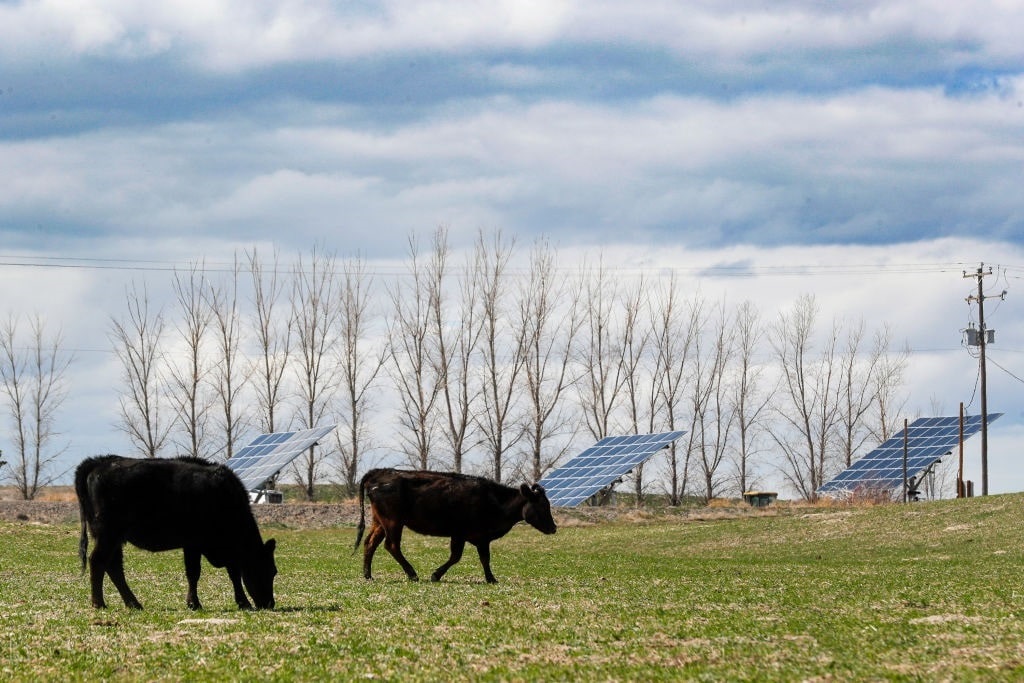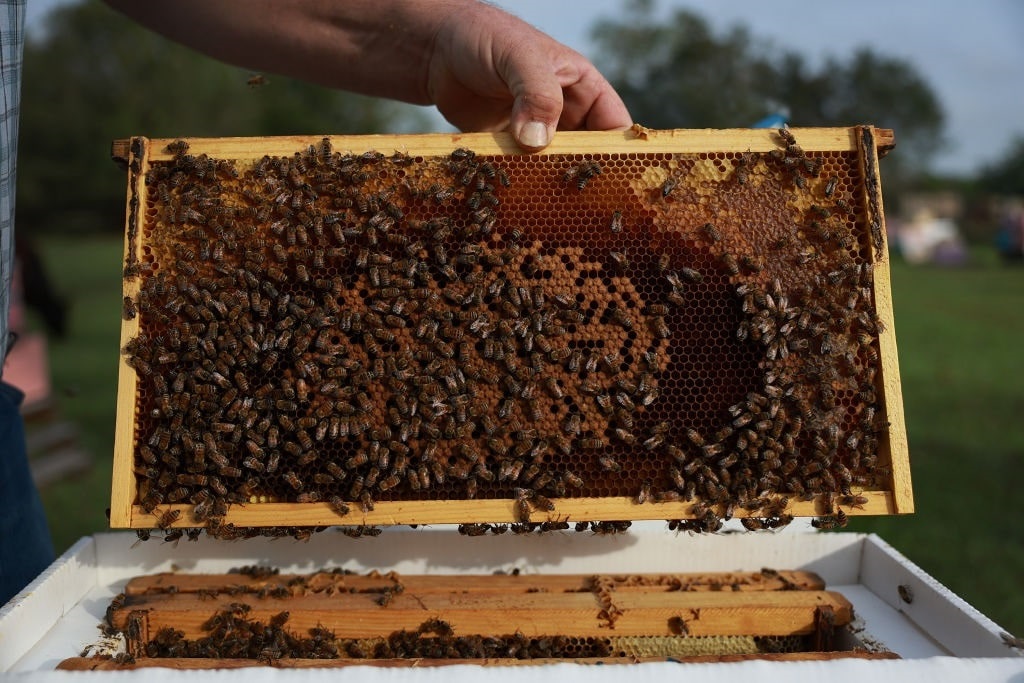'Agrivoltaics’ are touted to rebuild soils and shade plants, but ask a farmer about that.
by | Mar 4, 2024 @ Liberty Nation News Tags: Articles, Climate Change, Good Reads, Opinion

Recent studies claim ugly fields of solar panels, widely derided as destructive of local agricultural production and rural views, are beneficial to plants, pollinators, and soils. One ongoing Vermont experiment explored how “agrivoltaic” farming shares sunlight that falls between panels and crops; a Minnesota study concluded that these arrays restore bees and nurture polluted soils. Ironically, such efforts falsely advertise solar arrays as “high-tech processes to help with traditional farming practices.” Plants and bees have done okay for eons without silicon panel installations. The environmental liabilities of solar panels far outweigh their claimed benefits — and doubly so with regard to agriculture.
Solar power enthusiasts claim crops improve panel efficiency by
keeping them cool, helping farmers repair soils and increase crop
productivity. Two recent studies demonstrated the scheme to package
polluting solar panels as soil-saving.
The Vermont Study
The Vermont study posited that siting solar panels with crops will “enhance crop yields by providing shade from excessive sunlight” as well as “contribute to soil improvement by preserving moisture and preventing erosion.” Vermont is an ironic locale for the study, as it is about the worst state in the nation for clear, sunny days. Solar panels generally don’t need cooling (and don’t collect much sun) in Vermont. Conversely, plants grown in chilly, wet Vermont mostly don’t need drought protection or shielding from “excessive sunlight.”
The project was designed specifically for the Green Mountain State for other reasons:
“The selection of Vermont for this specific initiative is intentional. Researchers at the University of Vermont have been advocating for saffron cultivation as a means to support specialty crop farmers, ensuring their sustainability and preserving cultivated land for future generations.”
Saffron is a high-priced crop, permitting profitability despite Vermont’s fifth-highest real estate tax burden in the nation, inflated electricity rates that regressively fund solar panels, and skyrocketing land prices due to excessive state regulatory restrictions (aggravated by subsidies to “sequester carbon” by reforesting fertile farmlands). Instead of addressing these direct impacts on farmers, the technocratic answer is to plant saffron.
Out-of-state companies have been carpetbagging in Vermont for a century, selling farmers land-destroying gadgets that do more harm than good to the environment. From soil-compacting tractors to toxic chemicals like atrazine, glyphosate, and neonicotinoids, corporate America is always there to “rescue” Vermont’s farmers. Synthetic fertilizers that pollute Vermont’s waterways were subsidized by the same federal government that now bankroll solar panels, and the University of Vermont plans saffron farming crossed with rows of solar panels to “preserve cultivated land for future generations.”
The Soil and Bee Study
Another study by the US Department of Energy claimed that solar fields can become “breeding grounds for pollinators and native plants.” The research consisted of seeding the ground underneath solar panels with native plants and measuring the return of insects to the land “which had previously been fouled with herbicides and used for row crops.” It was discovered after five years that the populations of native bees had risen 20 times their initial levels, prompting the study’s leader to conclude, “This research highlights the relatively rapid insect community responses to habitat restoration at solar energy sites.” The purported conclusion was that such studies show “that solar farms … can generate clean energy while also supporting local wildlife.”

(Photo by Joe Raedle/Getty Images)
Similar studies of houses of prostitution and maximum security prisons will show that they, too, can restore lost bee populations if seeds are spread in their wake over previously abused agricultural lands. Only houses of prostitution and prisons do not pollute the planet on the scale that solar panel manufacturing does. Coal burned to form silicon for voltaic panel production doubtless emits bee-killing chemicals. Solar panel recycling and disposal present daunting environmental challenges. Solar farms do not generate clean energy, and they certainly do not restore bee populations. It was the spreading of seeds that restored bees, not unnatural plastic installations from China.
The Serial Farm Killers
High-tech promises of increased productivity by American corporations are what killed the family farm, tainted US food supplies with cancer-causing chemicals, wiped out bee populations, eroded vast amounts of soil, polluted and drained vital water resources, and sickened the soil microbiome of millions of acres of prime agricultural land. Now the same snake oil sales force has been recruited to create lipstick-on-a-pig “studies” that claim even more high-tech gizmos will profit the soil and farmer.
Do Vermont farmers need to grow saffron when the state cannot satisfy out-of-state demand for local grass-fed meats? The same cadre of experts who would rescue bees by installing vast arrays of solar panels tells us cows are bad and humans must switch to synthetic meats grown from GMO-cropped plants dependent on chemical fertilizers and herbicides, killing bees and microbiome to spare the world from cows. But cows rebuild soils and sequester carbon far more efficiently than any technology yet devised by human hand. God created solar panels called blades of grass that are not manufactured in China and dispose of themselves harmlessly.
Solar Panel Planetary Destruction
The mad craze to “save the world” through Earth-destroying renewables is accelerating planetary destruction. Solar panels will pollute more than they “save.” Farmers see this clearly – witness the revolts against climate change regulations in Europe.
To energize the world with “clean solar energy” would require an estimated 92.7 billion solar panels completely covering America’s 11 smallest states: that’s a lot of saffron! Then there are the toxic, currently non-recyclable batteries used in EVs but also necessary to store all that solar energy for the grid: Any impact on bees there, or will some seed-casting counter the lithium and nickel pollution?
At a time when Marie Antoinette CEOs advise Americans unable to afford hamburger to feed their children cornflakes for dinner, it is unsurprising that disconnected venture capitalists and grant-winning researchers portray solar panels as soil-building and plant-nurturing. The latest renewable energy skullduggery is that vast field arrays of solar panels feed bees and build soil, while soil-feeding cows must be eradicated.
Try selling that pitch to a farmer.
No comments:
Post a Comment